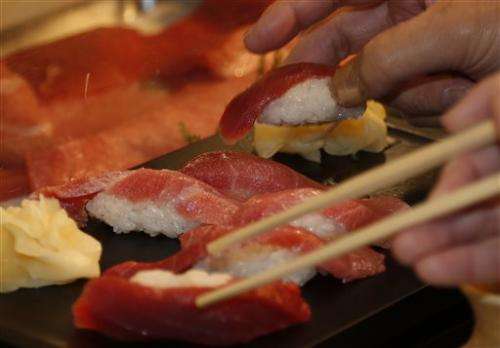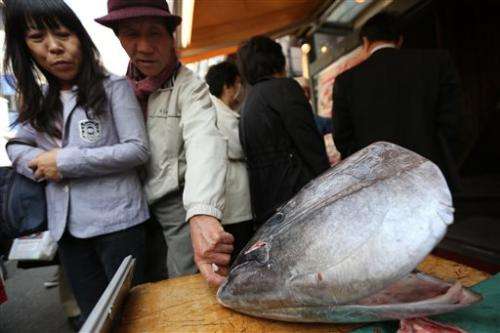Fisheries to cut catch of endangered bluefin tuna

aThe multi-nation fisheries body that monitors most of the Pacific Ocean has recommended a substantial cut to the catch of juvenile bluefin tuna, a move conservationists say is only an initial step toward saving the dwindling species.
The Western and Central Pacific Fisheries Commission announced the decision Thursday after meeting in Fukuoka, a city in western Japan. It said the catch should be cut to half of its average level in 2002-2004.
The commission, a grouping of more than 20 nations that monitors the western two-thirds of the Pacific, also endorsed catch limits for adult bluefin and set a 10-year target of rebuilding the population to 8 percent of its original size.
Japanese eat 80 percent of the world's bluefin tuna, or "hon maguro," a sushi mainstay, and demand elsewhere in the world has kept growing. At a ritual new year auction, the top price for the fish jumped to about $7,000 a kilogram in 2013 but was a more reasonable $300 per kilogram this year.
The Pew Charitable Trusts, which is trying to save the species, said the plan to cut catches is only a first step toward saving the bluefin tuna, which has been decimated by overfishing.
"There must be a strong recovery and rebuilding plan put in place for Pacific bluefin across its full range," said Amanda Nickson, director of global tuna conservation for Pew.
"Countries have the responsibility to agree on a strong recovery plan that does more than simply move the population from severely depleted to slightly less seriously depleted," she said.

The fisheries commission left a decision on longer-term efforts for later. It also approved a recommendation that stocks of albacore tuna do not drop more than 20 percent from their current level. Stocks of swordfish were judged to be healthy, it said.
Nations that manage the eastern Pacific bluefin fisheries are due to discuss their management plans for the species next month, and a final decision on the catch limits for the western Pacific is expected in December.
A stock assessment by the International Scientific Committee for Tuna and Tuna-like Species in the Northern Pacific Ocean found the levels of bluefin in 2012 at near their lowest ever of just 4 percent of original stocks.
Most of the fish caught are juveniles that have not had a chance to reproduce, the scientific body said.
Cutting the catch in half would reduce Japan's annual catch of juvenile bluefins to about 4,000 tons from next year, out of a fisheries-wide catch of 4,725 tons.
The catch of adult fish weighing over 30 kilograms would be 4,882 tons out of a total regional catch of 6,591 tons, according to an announcement posted on the Japanese fisheries ministry's website.
Fisheries experts in Japan are rushing to devise techniques for commercially viable aquaculture of the deep-sea species.
There have been other recent measures to help bluefins, which sometimes grow to the size of small cars.
The U.S. National Oceanic and Atmospheric Administration last month issued stricter quotas for bycatches, or unintentional catches, of Atlantic bluefin tunas on surface longlines meant to catch other species.
Earlier this year, the EU proposed banning all use of driftnets in its waters and on its vessels by the year's end to better enforce the protection of dolphins, sharks, swordfish and bluefin tuna. Such nets, which stretch for miles close to the surface, tend to have huge bycatches, and often were used illegally to catch bluefin tuna.
© 2014 The Associated Press. All rights reserved.


















